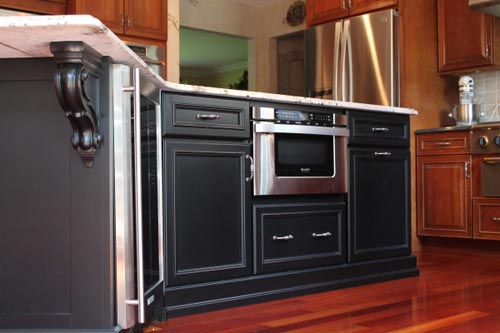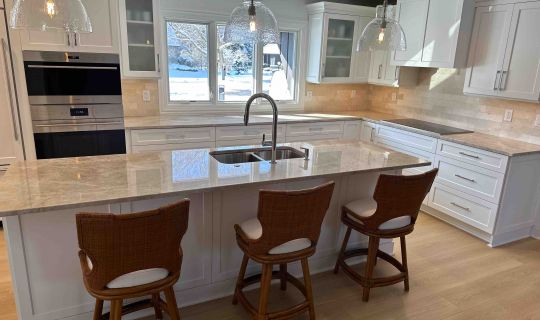When Your Granite Countertop Needs Support
Designing, fabricating and installing a new custom granite or quartz countertop is a significant investment, and creative buyers want to know all available design options to make their kitchen one of a kind. Part of a good design is optimal usage of space. Granite overhangs are a great way to increase the counter surface area of your kitchen without losing space beneath.
Kitchen islands, breakfast bars, and counters with overhangs allow for comfortable seating with legroom beneath the countertop. Remember, overhangs made from stone even as strong as granite require the proper support to prevent cracking under the weight - there is a limit to the length of an overhang.

Granite Thickness and Overhangs
The length of granite overhang available without support depends on a few factors:
Granite thickness – granite tops with a thickness of 3 cm can have an 8-10 inch overhang without additional supports. If your granite top has a 2 cm thickness, we recommend attaching a support system should the overhang exceed 6 inches.
Total width of top – no matter the size of the piece, the overhanging portion should not exceed 1/3 of the total width of the top without additional supports like corbels or steel brackets. This means 2/3 of the top must be cantilevered by its base.
Granite Top Support Types
If your stone countertop will require additional supports, there are a few options to consider:

Corbels – these visible supports wedge between the horizontal surface of the top and the vertical surface of the cabinet on which the top rests. They can be extremely ornate or plain and are commonly made of wood, but can also be carved from stone. Advantages: Offers good support by effectively extending the cantilevered surface area of the top. They can also be a nice decorative touch. Disadvantage: Reduces space available under the counter top; you may hit your knees on corbels when you sit at the counter.
Legs – countertop legs provide excellent support by adding the additional cantilever at the extreme end of the overhang. Advantages: Allows for extensive lengthening of the overhang, and can be decorated for aesthetics value. Disadvantages: Greatly hinders available legroom beneath the table top; also eliminates the “floating countertop” look.
Brackets – also extends the surface area of the cantilever to give effective support. Advantages: inexpensive, effective and invisible. Disadvantages: works better on wall overhangs than cabinet top overhangs. Caveat: higher-end brackets can be integrated into the cabinet before the top is installed. These offer the best option for invisible support, but cost more.
Rods – Steel rebar rods can be installed into the stone piece to provide reinforcement throughout the top. Advantage: strengthens the entire length of the piece and will eliminate cracking in overhangs. Disadvantage: does not lend toward additional cantilevering, so while it is unlikely to crack, the entire top loses stability.
All Stone Countertop Installers Understand Overhangs
At All Stone Tops we’ll make sure your stone countertop is installed correctly with properly supported overhangs. We want you to love your countertop for the entirety of its lifespan, and only proper installation and support from All Stone Tops will assure you of a long one.



